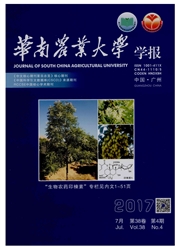

 中文摘要:
中文摘要:
【目的】建立三峡库区兰陵溪流域森林土壤有机碳、有机质与容重之间的回归模型,完善土壤属性数据库。【方法】利用该流域森林土壤调查数据库,确立土壤有机质(SOM)与有机碳(SOC)间的转换系数,构建土壤容重(BD)与SOM(SOC)含量之间的回归模型,并使用决定系数(R2)、Nash-Sutcliffe效率系数(E)、百分误差(Pe)等统计参量进行检验。【结果】Van Bemmelen转换系数(0.58)不适合该研究区(R2=0.62,E=0.51、Pe=-31.16%),SOC-SOD转换系数应该为0.455(R2=0.85,E=0.86、Pe=-3.0%),不同深度SOC-SOD转换系数并不相同,随土壤深度的增加迅速降低;其他地区构建的BD-SOM(SOC)回归模型不能直接应用于该区域,BD-SOM模型参数优化后可应用于该区域;BD-SOC模型参数优化后,对数多项式模型可以用于该区域。【结论】BD-SOM回归模型模拟值优于BD-SOC模型,建议使用BD-SOM回归模型进行土壤数据库完善。其中效率最高、误差最小的模型为Federer有机密度模型(R2=0.75,E=0.81,Pe=5.4%),可以在该地区推广应用。
 英文摘要:
英文摘要:
【Objective】To establish regression models of soil organic carbon,organic matter and bulk density for forest soils and improve the regional soil attribute database in Lanlingxi watershed,Three Gorges Reservoir area.【Method】Using forest soil survey data of this watershed,the conversion factor for soil organic matter( SOM) to soil organic carbon( SOC) was established,and the regression models linking soil bulk density( BD) and SOM( SOC) content were built. The whole evaluation consisted of determining the coefficient of determination( R2),Nash-Sutcliffe coefficient of efficiency( E),and the percentage error( Pe). 【Result】The Van Bemmelen conversion coefficient( 0. 58) could not be directly applied in this watershed. The proper SOC-SOM conversion coefficient was 0. 455,as SOC-SOD conversioncoefficients varied from different depth of soil,declining quickly with the increase of depth. The BD-SOM( SOC) regression models built in other regions could not be directly applied to this region. When parameters of the BD-SOM models were optimized,the logarithm polynomial model could be used for this region. 【Conclusion】Overall,the simulated values of BD-SOM regression models are better than those of BD-SOC models,and it is recommended to use BD-SOM regression models to improve the soil database.Among the optimized BD-SOM models,the recommended model for this study is Federer organic density model with the highest efficiency( E = 0. 81) and the lowest error( Pe= 5. 4%).
 同期刊论文项目
同期刊论文项目
 同项目期刊论文
同项目期刊论文
 期刊信息
期刊信息
